Learn how to optimize your fashion brand’s product detail pages for AI-driven search and answer engines with this complete AEO checklist. Free download.
by YesPlz.AIOctober 2025

For years, search engine optimization (SEO) has been the main driver of online visibility. But today, shoppers aren’t just typing keywords into traditional search engines like Google, Bing, or Yahoo. They’re also asking questions to AI chatbots or answer engines, let’s say, ChatGPT, Perplexity AI, or Claude. This shift is where answer engine optimization (AEO) becomes critical.
In this guide, we walk you through:
A comprehensive AEO checklist, specifically designed for fashion brands.
How AI tools can help you implement it at scale.
By the end, you’ll have a downloadable checklist to optimize your fashion catalog in the age of answer engines.
Table of Contents:
In the context of fashion, AEO refers to optimizing product detail pages (PDPs) to:
Appear as direct answers to shopper queries in answer engines:
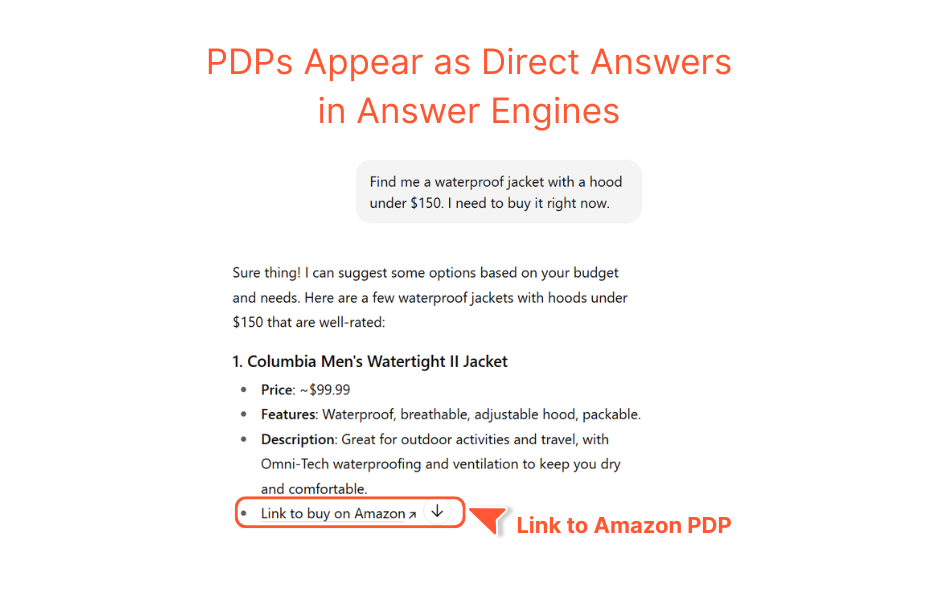
Show up in Google Free Product Listings
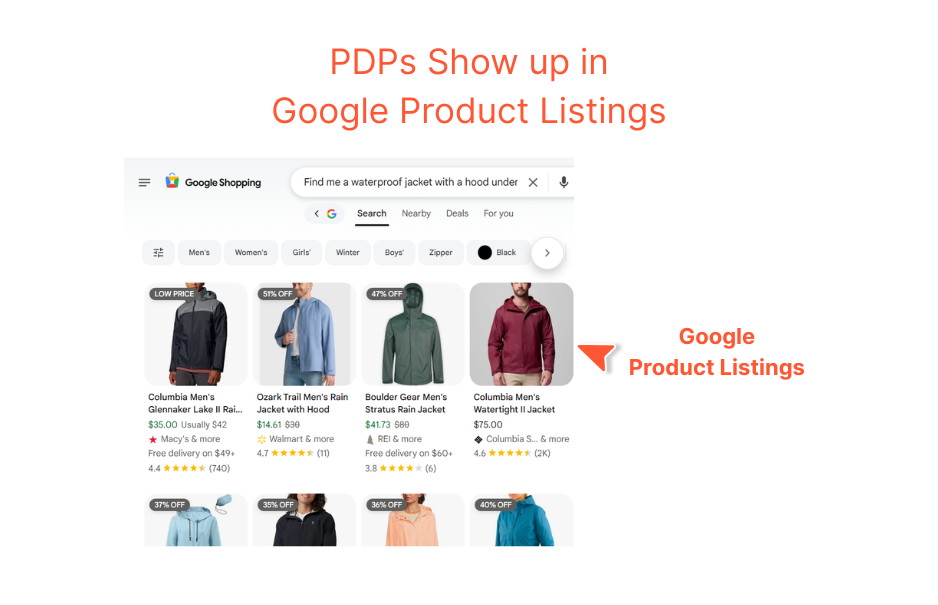 Google Product Listings can include both paid ads (sponsored placement) and free listings. But in this guide, our focus is on the latter. It is the organic product visibility you can achieve without advertising spend.
Google Product Listings can include both paid ads (sponsored placement) and free listings. But in this guide, our focus is on the latter. It is the organic product visibility you can achieve without advertising spend.
Traditional SEO focuses on ranking well in a list of blue links. Meanwhile, AEO helps your products gain visibility in high-intent placements.
The fashion industry is experiencing a seismic shift in how shoppers search for and discover products. Voice search has grown exponentially. AI chatbots are becoming shopping companions. Google increasingly provides direct answers that reduce the need to click through websites.
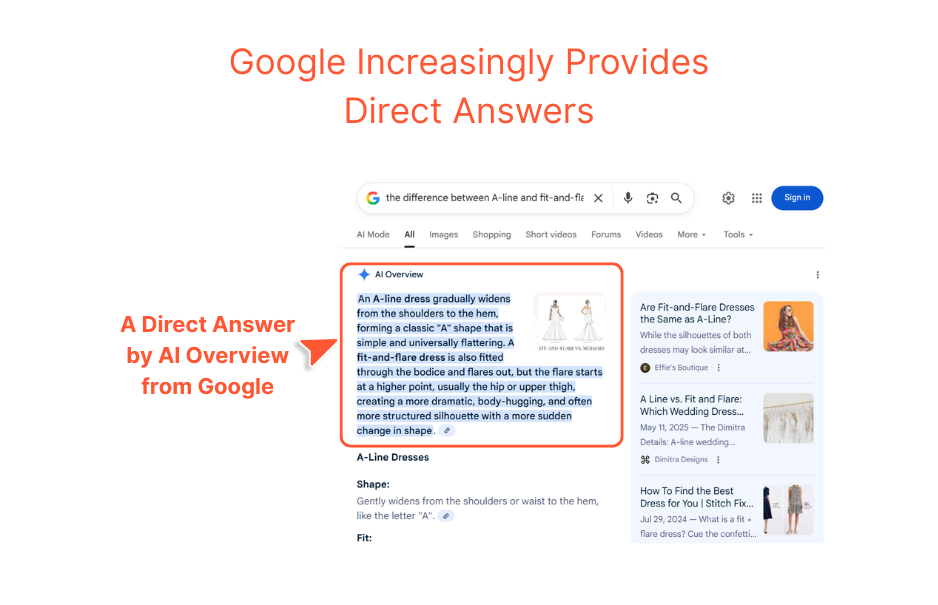 For fashion brands, this shift creates both a challenge and an opportunity. The challenge is that shoppers may never reach your website if your competitor's PDPs appear in high-intent placements.
For fashion brands, this shift creates both a challenge and an opportunity. The challenge is that shoppers may never reach your website if your competitor's PDPs appear in high-intent placements.
How about the opportunity? With the right AEO strategy, you can capture shopper attention at the exact moment of intent. You can provide them with the precise information they need about fabric content, sizing, care instructions, or styling advice.
Moreover, fashion queries are uniquely suited to AEO. They are often conversational, specific, and question-based. For example:
Find me a waterproof jacket with a hood under $150. I need to buy it right now.
The difference between an A-line and a fit-and-flare dress?
How do I style wide-leg jeans?
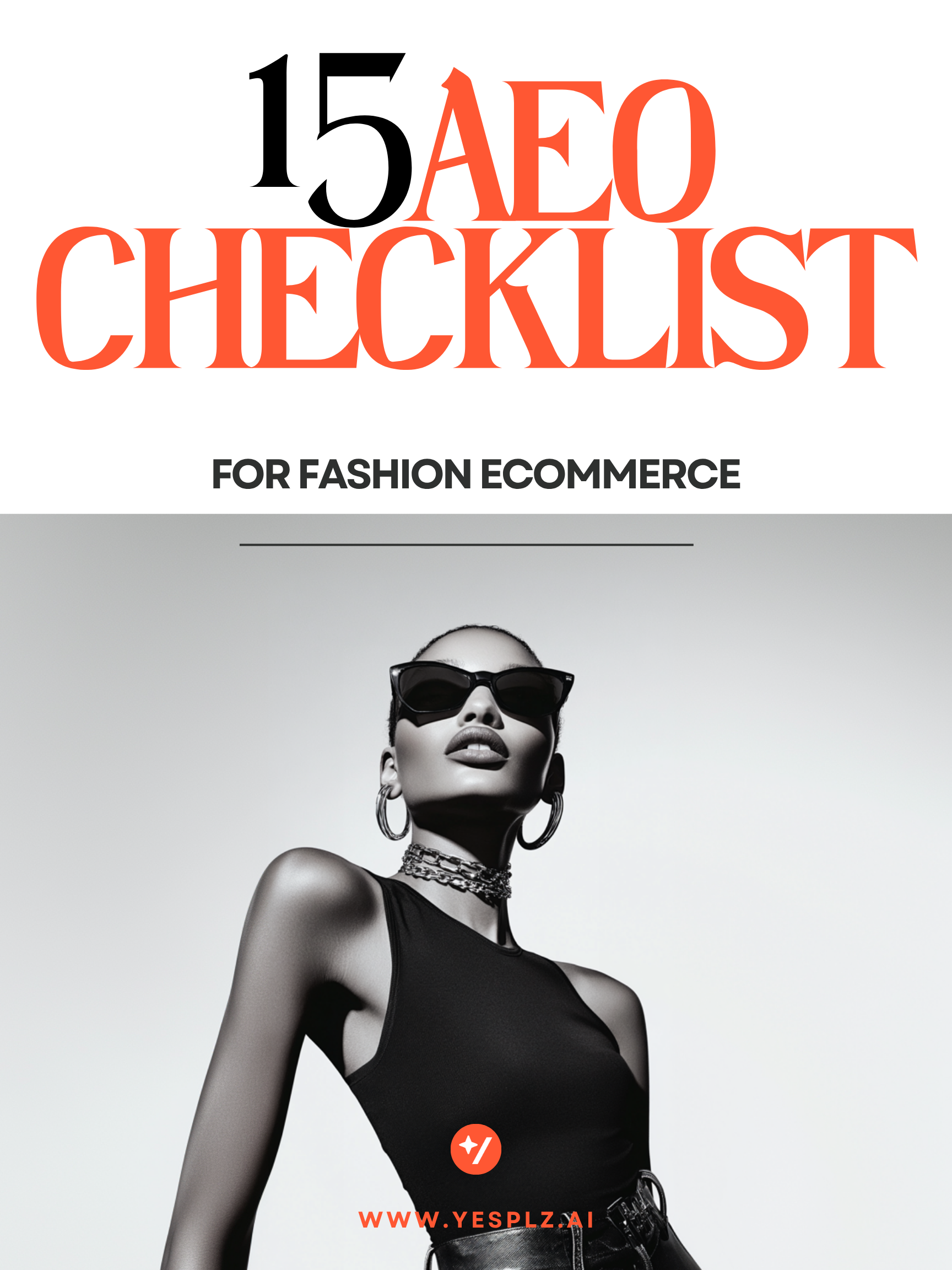
Unlock the proven strategies top fashion brands use to dominate answer engine optimization.
Inside this checklist, you’ll discover actionable tips and must-have optimizations to boost your product page visibility!
Now that you understand what AEO is and why it matters, it’s time to translate strategy into action. The following checklist breaks down every key area your fashion brand should optimize, from content and schema markup to AI implementation. Use it as your roadmap to build PDPs that answer shopper questions and rank across both search and answer engines.
Either search engines or answer engines can only provide answers as good as the data you supply. Incomplete or inaccurate product information means missed opportunities to appear in high shopping intent placements. For fashion brands, comprehensive product data is the backbone of AEO's success.
Create unique content about your products targeted to your specific shoppers. Instead of relying on manufacturer-provided descriptions, craft content that addresses what your shoppers truly care about. Each item should be tagged with comprehensive attributes that go far beyond basic categorization.
Include specific information such as:
Material Type: Cotton, polyester, wool, silk, leather, denim, cashmere…
Fabric Weight and Feel: Lightweight, breathable, substantial, structured…
Length: Mini, midi, maxi, ankle-length, knee-length, cropped…
Sleeve Length: Sleeveless, short sleeve, ¾ sleeve, long sleeve, cap sleeve…
Neckline: Crew neck, V-neck, scoop neck, high neck, off-shoulder, halter…
Closure Type: Button-up, zip-up, pull-over, tie, hook-and-eye…
Style Characteristics: Bohemian, minimalist, vintage, modern, classic, trendy…
Special Features: Pockets, adjustable straps, hidden zippers, built-in bra…
Color: Use specific color names (e.g., not just “blue” but “navy blue,” “cobalt blue,” “sky blue”)
Pattern: Solid, floral, striped, plaid, geometric, animal print, abstract…
Seasonal Appropriateness: Perfect for spring and summer, warm enough for winter, all-seasons…
Occasion: Office-appropriate, cocktail party ready, casual weekend wear, wedding guest appropriate, athletic, loungewear…
Care Requirements: Machine washable, dry clean only, hand wash, delicate cycle…
Sustainability Attributes: Organic, recycled materials, ethically made, vegan…
The more granular your attributes, the more specific queries your products can match. A dress tagged as "floral print, V-neck, midi length, short sleeves, spring/summer, wedding guest appropriate, has pockets" can appear for dozens of multi-attribute queries.
These four elements work together to communicate product information to search engines, answer engines, and potential shoppers.
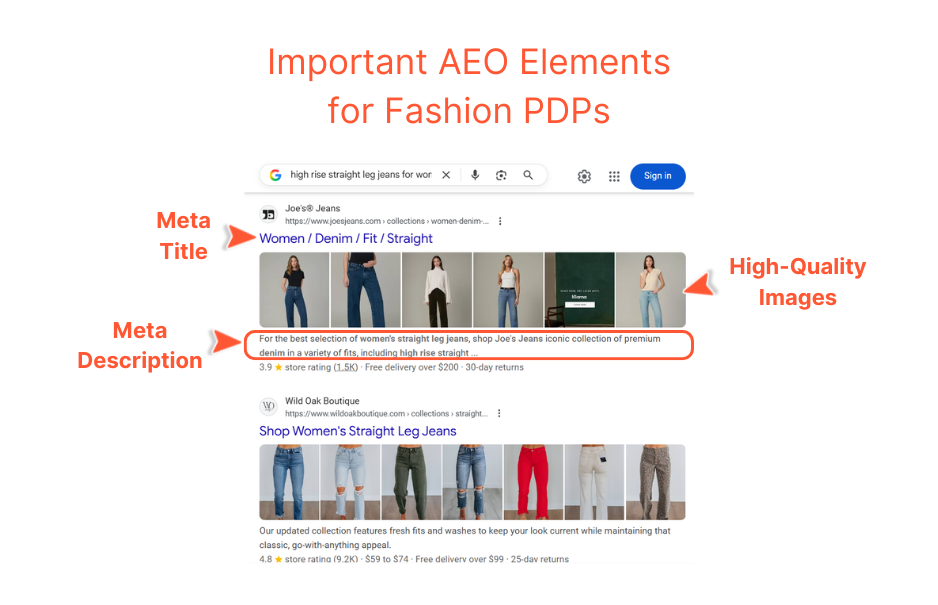
Meta Title Best Practices: Meta titles should be between 55 and 60 characters to avoid being cut off in search results. Include your most important keywords naturally along with your brand name. You can refer to this formula: [Product Name] - [Key Attributes] | [Brand Name]. Key attributes should match high-volume searches, such as special features or unique value propositions. Avoid keyword stuffing. Just keep it natural and descriptive.
Meta Description Best Practices: Meta descriptions should be between 155 and 160 characters. Use this space to highlight special features and unique selling points, or answer common questions.
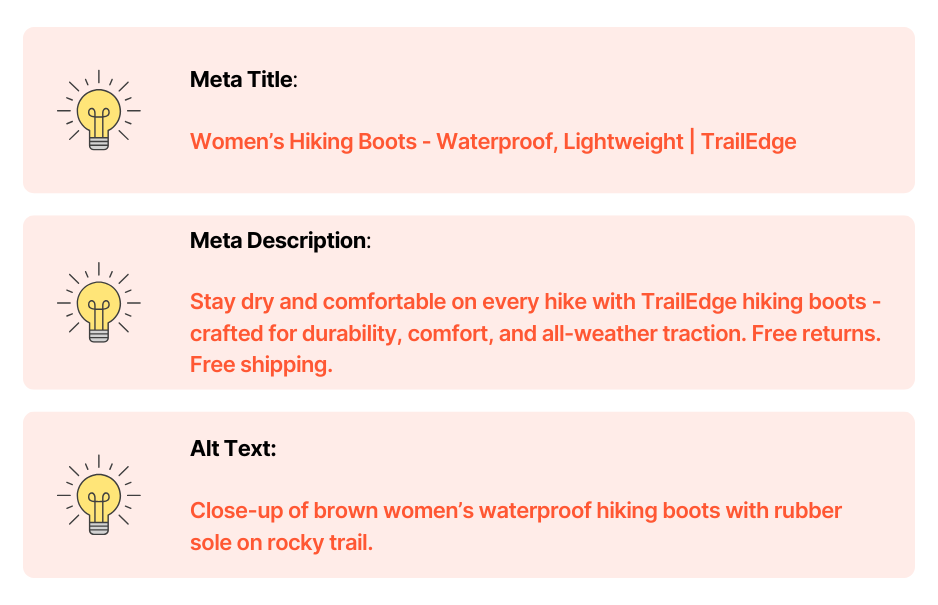
High-Quality Images Best Practices: Product images are often the first thing shoppers notice in search results and product listings. Ensure your images are high-quality and eye-catching as they will significantly impact click-through rates and conversions.
Descriptive Alt Text Best Practices: Alt text, short for alternative text, is a brief written description of an image on a webpage. This element serves dual purposes. For visually impaired people, screen readers read the alt text aloud to help them understand the image content. Search engines and answer engines also can’t “see” images. They rely on alt text to know what it is about. Alt text, therefore, should describe directly what is shown in the image. Don’t just repeat the product name.
When these elements are well-optimized, it helps:
Improve click-through rates
Provide concise information on voice search responses
Increase visibility in image search results
Allow answer engines to describe and recommend products accurately
Many shoppers abandon carts because they’re unsure about fit. And returns often happen for the same reason: the product doesn’t fit as expected. That’s why size guides and fit information are essential for every fashion PDP.
They do more than help shoppers find the right size. They build trust, improve the online shopping experience, and reduce return rates. When shoppers know exactly how an item will fit, they’re more confident to purchase and less likely to return it.
Examples of size guides:
Measurement Charts: Bust, waist, and hip measurements for each size
Size Conversion Charts: US, UK, EU sizing equivalents
Fit Descriptions: “This item runs small, we recommend sizing up.” or “Relaxed fit with room through the body.”
Between-Size Guidance: “If you’re between sizes, size down for a fitted look or size up for a relaxed fit.”
Model Measurements: Model height, clothing size worn, and how it fits on the model.
Examples of fit information:
Body Type Recommendation: Which styles work best for different body shapes
Length Guidance: “For customers 5'4" and under, this will hit below the knee.”
Comparison to Other Products: “Fits similar to our bestselling [Product name]”
Fabric Stretch Information: “Fabric has 10% stretch for comfort and movement.”
It’s best to include fit videos or photos that show the same product on different body types, heights, and sizes. These visuals help shoppers imagine how the item fits. So, they can make confident purchase decisions. Plus, videos and images create rich visual content that can enhance your visibility in search and answer engines.
Google Product Listings and answer engines favor PDPs with plenty of reviews because they signal credibility. Items with higher ratings and more reviews tend to have better high-intent placement and attract more clicks.
These elements also enhance schema markup (you will learn about it in the next section). They directly impact how search and answer engines understand and feature your products.
Plus, reviews often address common shopper questions that product descriptions may overlook. Take the following examples:
“This dress is perfect for a summer wedding.” - Helps match wedding guest searches.
“Runs true to size, I’m 5'6" and the midi length hits perfectly.” - Provides fit context.
“This fabric is thicker than expected, great for fall.” - Clarifies seasonal use.
“Pockets are deep enough for my phone!” - Highlights popular features.
Getting shoppers to leave reviews requires a strategic and systematic approach. Below are some proven methods to increase review volume and quality:
Automate post-purchase review requests with personalized subject lines: “Hi [Shopper Name], How’s your [Product Name] working out?” “Does your new [Product Name] fit perfectly?”
Simplify the review process: One-click access, pre-fill information, rating-only option, photo/video uploads…
Ask specific questions: “Would you recommend sizing up or down?” “How would you describe the fabric quality?” “How did you style this piece?”
Offer incentives: Discount on next purchase, loyalty points, free shipping…
The foundation of AEO is content that directly answers shoppers' questions in clear, natural language. Fashion brands need to think beyond product specifications. It’s better to consider the full context of how shoppers make purchasing decisions. Include common questions such as styling advice, return policies, and shipping policies in a dedicated FAQ section.
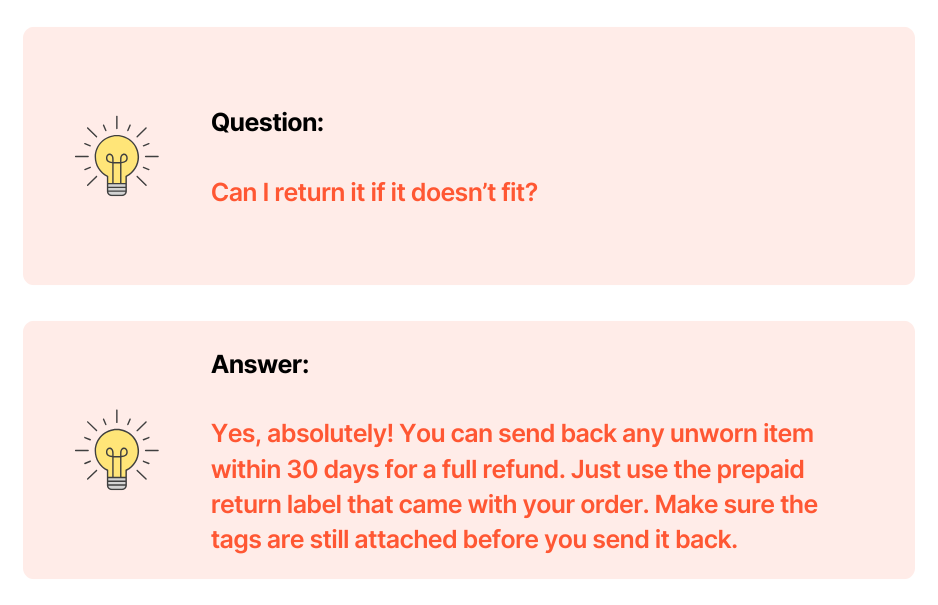 FAQs can serve multiple purposes:
FAQs can serve multiple purposes:
Reducing customer service inquiries
Improving conversion rates by addressing purchase hesitations
Creating AEO-friendly content that captures voice search and direct answer opportunities
You can place this section near the purchase button. Use the actual shopper question as an H2 or H3 heading, followed immediately by a clear answer. These question-and-answer pairs should reflect real shopper language. Each answer should be comprehensive yet concise. It typically includes two to four sentences that fully address the question without unnecessary fluff.
Traditional SEO favors keyword-focused and compressed language that often sounds robotic. Keyword-stuffed phrases may once have boosted rankings. Yet, they disrupt readability and fail to connect with real users. Modern AI platforms and voice assistants such as Alexa and Google Assistant prioritize content that flows naturally when read aloud. To succeed in the AEO environment, your content must sound like a human response to those spoken queries.
In reality, people rarely talk in keyword fragments. Instead, they ask complete, conversational questions that reflect real intent. For example, traditional SEO optimizes for "women's winter coats." Meanwhile, AEO optimizes for "What's the warmest women’s coat for temperatures below 20 degrees?" One targets keywords; the other targets intent and context.
By optimizing for long-tail, question-based keywords, you align your content with shopper intent: what they truly want, not just what they happen to type. This approach helps your content perform better in voice search and AI recommendations while making it more natural, engaging, and human-centered.
Great content alone isn’t enough. For AEO to work, engines need structured, machine-readable data. The following implementation practices make your PDPs fully compatible with the language of search and answer engines.
Structured data is another key element of AEO. It helps search and answer engines understand exactly what your PDP is about in a language that these engines can process. Schema.org markup is that language.
JSON-LD is simply a way to add structured information to your website that’s invisible to human visitors but clearly readable by engines. Think of it as adding special labels or tags in the background code of your website that guide these engines: “This is the product name,” “This is a price,” “This is a shopper review.”)
Imagine you sell women’s winter coats. On its PDPs, your shoppers see the coat’s name, price, description, and reviews from other shoppers. However, to engines, they don’t know what’s what. That’s where JSON-LD comes in.
For example, the structured data might look like this:
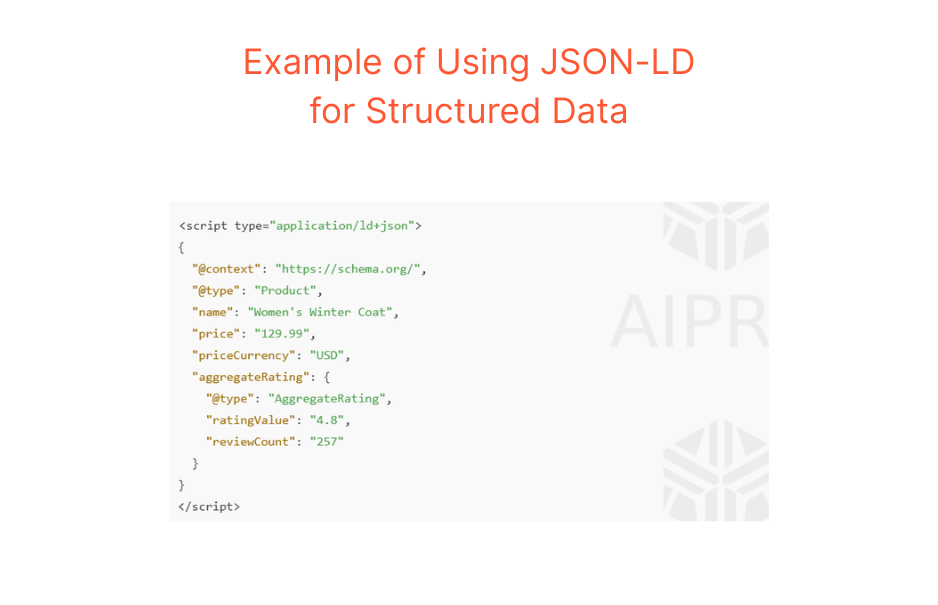 This block of code is invisible to shoppers. Yet, it tells search and answer engines exactly what your page contains. For example, a product named Women’s Winter Coat, its price ($129.99), and its review score ( a 4.8-star rating based on 257 reviews). That’s the power of using JSON-LD for structured data. It helps your content speak the same language as the engines without affecting how your PDPs will look.
This block of code is invisible to shoppers. Yet, it tells search and answer engines exactly what your page contains. For example, a product named Women’s Winter Coat, its price ($129.99), and its review score ( a 4.8-star rating based on 257 reviews). That’s the power of using JSON-LD for structured data. It helps your content speak the same language as the engines without affecting how your PDPs will look.
Actually, you don’t need to understand the technical details. Your development team will implement it. However, you should know that JSON-LD is Google’s preferred format. It’s clean and doesn’t clutter your visible webpages.
Once your PDPs are set up to use JSON-LD, ensure they include the right types of schema. At a minimum, fashion PDPs should cover:
Product schema (name, image, description)
Offer schema (price, currency, availability)
Review schema (rating, comments, verified buyers)
More advanced implementation might include:
FAQPage schema (common shopper questions and answers)
HowTo schema (styling guide)
Breadcrumb schema (navigation paths for categories and collections)
Organization schema (brand, logo, store locations, social links)
Mobile-first is non-negotiable for AEO. Voice searches predominantly happen on mobile devices, and Google’s indexing is mobile-first. Ensure your PDPs load quickly, images are optimized, and text is easily readable on small screens. Speed directly impacts whether your PDPs get selected for direct answers and AI recommendations.
Monitor your Core Web Vitals. These are Google’s way of measuring how fast and smooth your website feels to shoppers. Think of them as a website’s performance report card with three main grades:
Largest Contentful Paints (LCP): How quickly the main content of your PDPs loads. Good LCP means that when someone visits a page, they see images and text within 2.5 seconds. Slow loading frustrates shoppers and tells Google your site isn’t reliable enough to recommend.
First Input Delay (FID): How quickly your page responds when someone clicks a button. If there’s a lag between clicking “Add to Cart” and the site responding, that’s poor FID.
Cumulative Layout Shift (CLS): Whether elements on your page jump around while loading. You know that annoying experience when you’re about to click a button, but an image loads and pushes everything down, so you click the wrong thing. That’s a layout shift, and it frustrates shoppers.
These metrics don’t just affect shopper experience. They influence whether engines consider your content authoritative enough to feature as direct answers. These engines won’t promote slow, chunky websites. Your technical team can measure these using Google’s PageSpeed Insight tool.
Scaling AEO manually is tough. Every product needs accurate tags, complete descriptions, and consistent formatting. That’s where AI changes the game. It automates what once took hours into minutes. Let’s start with the first and most transformative use case: AI-driven product tagging.
Manually product tagging presents significant challenges for fashion retailers. Merchandising teams spend countless hours categorizing products. This often results in inconsistent tagging across the entire catalog. Some products have comprehensive attributes. Meanwhile, others have only basic information. Subjective attributes like “style” or “vibe” vary by who’s doing the tagging. Missing attributes mean missed search opportunities. If a product isn’t tagged with “V-neck,” it won’t appear when a shopper filters V-neck style.
AI-powered image tagging solves these challenges. This tech automatically analyzes product images and identifies attributes. It can detect dozens of attributes simultaneously:
Neckline style
Sleeve length
Hem length
Silhouette
Pattern
Specific color shades
Fabric texture
Closure types
Stylistic details like ruffles, pleats, or embellishments
etc.
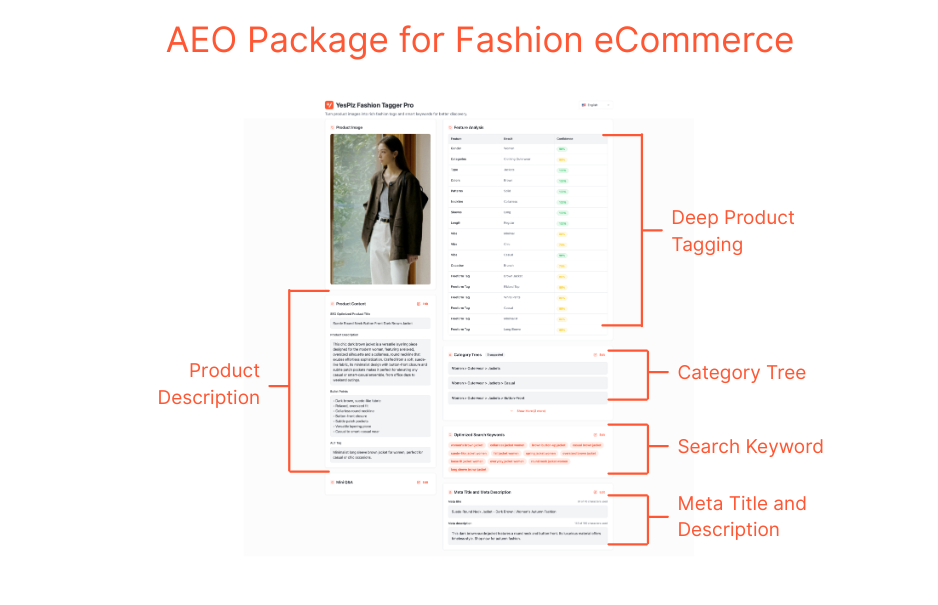 This consistency is transformative. Every product in your catalog receives the same comprehensive analysis. AI tagging ensures complete and accurate tagging across all items. New products get tagged immediately upon upload, making them searchable the moment they’re added to your system. Seasonal updates or retagging campaigns that might take merchandising teams weeks can be completed in hours.
This consistency is transformative. Every product in your catalog receives the same comprehensive analysis. AI tagging ensures complete and accurate tagging across all items. New products get tagged immediately upon upload, making them searchable the moment they’re added to your system. Seasonal updates or retagging campaigns that might take merchandising teams weeks can be completed in hours.
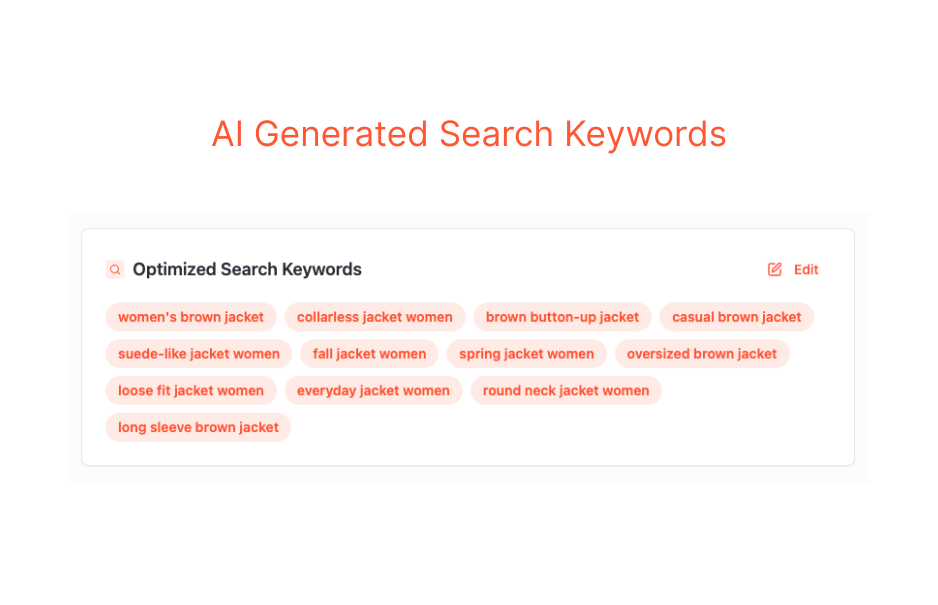 Beyond image tagging, AI automatically generates optimized search keywords that match how shoppers actually search for products. It analyzes product images and shopper search patterns to create comprehensive keyword sets. For instance:
Beyond image tagging, AI automatically generates optimized search keywords that match how shoppers actually search for products. It analyzes product images and shopper search patterns to create comprehensive keyword sets. For instance:
Descriptive phrases ("women's brown jacket")
Style variations ("suede-like jacket women")
Seasonal terms ("fall jacket women")
Fit descriptors ("loose fit jacket women")
Multi-attribute combinations ("brown button-up jacket")
etc.
With AI power, fashion retailers no longer rely on merchandisers to manually brainstorm every possible search term. AI leverages machine learning trained on millions of fashion searches to identify the most relevant keyword combinations. This ensures your PDPs appear for diverse queries, from broad to specific searches.
When each product has complete, accurate attributes, your schema markup becomes rich and comprehensive. Search and answer engines can confidently understand exactly what each PDP is and match it to specific queries.
A manually tagged catalog might have 60% of products with complete attributes. AI can achieve 95%+ completeness. This means these engines have more of your products to choose from when answering shopper queries. This dramatically increases your chances of appearing in direct answers, voice searches, and Google Product Free Listing.
The challenge with traditional catalog management is maintaining quality at scale. There may be a lack of optimization in meta titles and meta descriptions. Alt text of images is missing. Product descriptions may be incomplete, missing key details that shoppers ask about. Information is inconsistent. Sizing descriptions vary from product to product. Care instructions are formatted differently. Scaling content creation across thousands of PDPs while maintaining quality and brand voice is nearly impossible with human resources alone.
An AI-powered catalog manager can solve these challenges. It harnesses image tagging data to identify what makes each product distinct. Then, craft descriptions that naturally incorporate these details. These descriptions are written in conversational language that mirrors how shoppers search. It also automatically generates keyword-rich meta titles and descriptions.
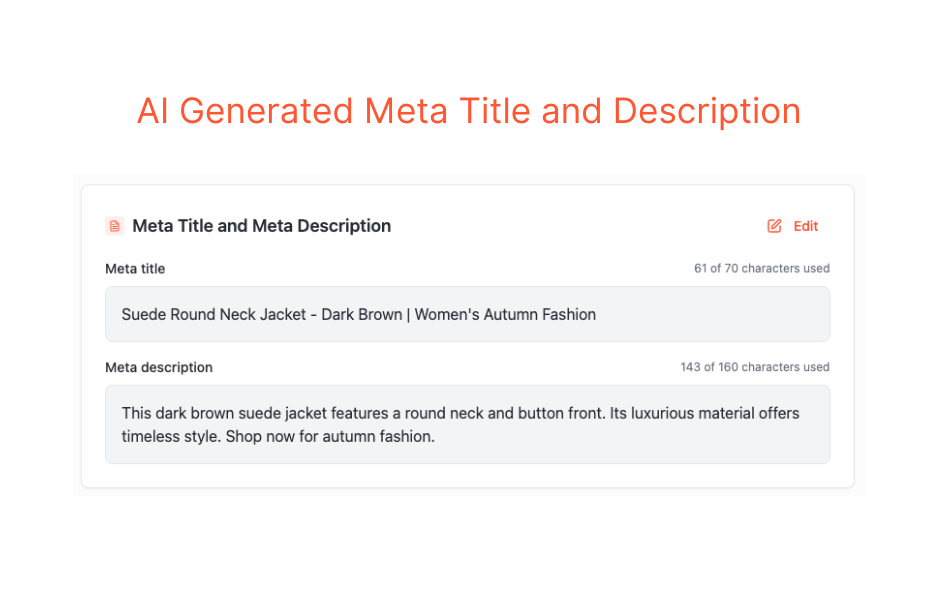 For brands operating in multiple markets, an AI catalog management platform can translate product content while maintaining accuracy and brand voice across languages. This ensures your AEO optimization extends to international markets.
For brands operating in multiple markets, an AI catalog management platform can translate product content while maintaining accuracy and brand voice across languages. This ensures your AEO optimization extends to international markets.
AI catalog management brings structure and consistency to product data. This is a foundation of strong AEO performance. Regardless of catalog size, it ensures every SKU follows the same optimized format with complete, high-quality metadata. This consistency improves how search and answer engines understand and rank your product pages.
By optimizing all products equally, not just top sellers, AI expands your visibility across a broader range of search queries. Long-tail and niche items become discoverable through detailed, keyword-rich descriptions that align with shopper intent.
SEO once ruled online visibility. But shoppers today aren’t searching, they’re asking. They turn to AI assistants and answer engines for direct answers. In this new landscape, fashion brands can’t rely on keywords alone. You need PDPs that answer.
Ready to optimize your fashion catalog for answer engines and Google Free Product Listings?
This comprehensive checklist includes 15 actionable optimization points across:
Content Optimization (11 checkpoints)
Technical Implementation (4 checkpoints)
Start checking off items today and position your brand for the future of search.

Unlock the proven strategies top fashion brands use to dominate answer engine optimization.
Inside this checklist, you’ll discover actionable tips and must-have optimizations to boost your product page visibility!

Written by YesPlz.AI
We build the next gen visual search & recommendation for online fashion retailers
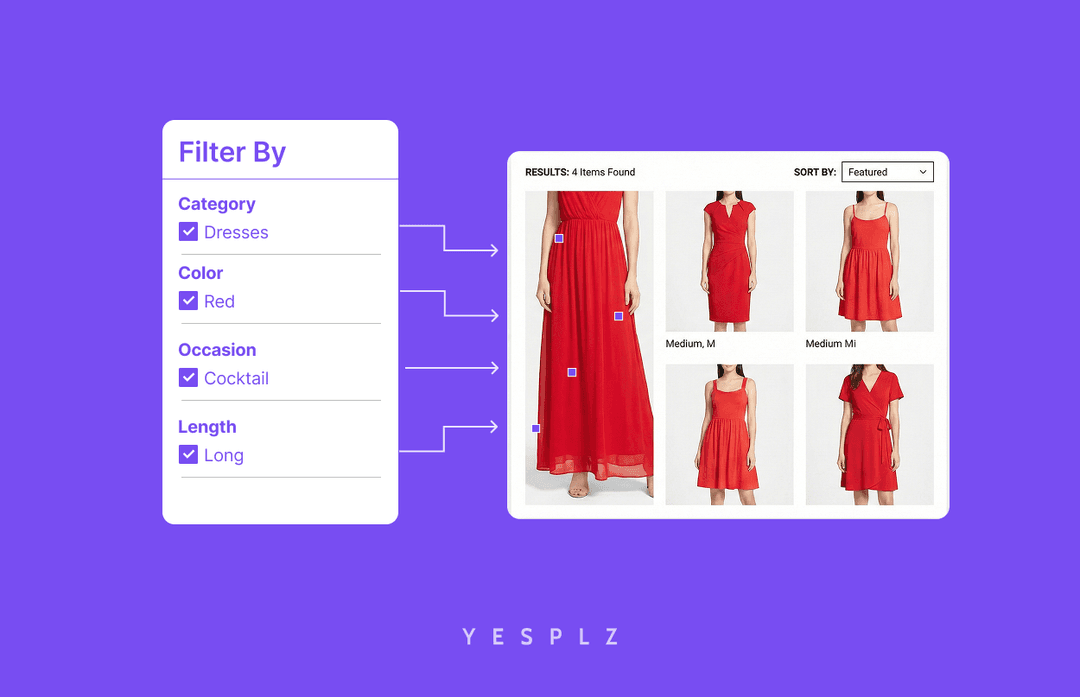
Stop losing sales to poor product filtering. Discover how AI simplifies creating Shopify filters, saving you 25-50 hours per 100 products.
by YesPlz.AI
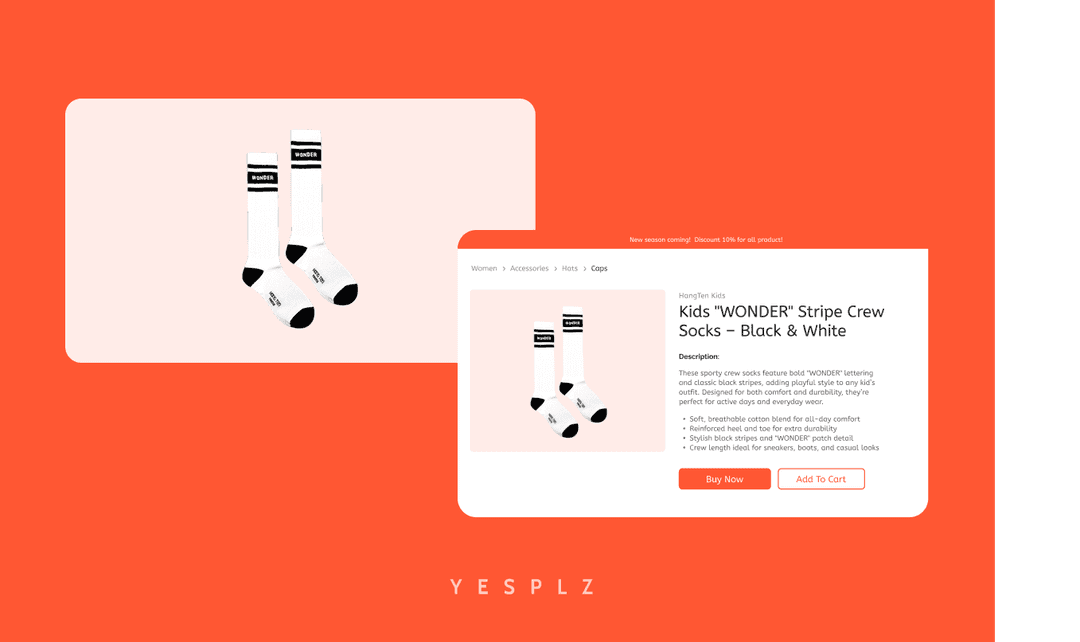
Automate Shopify product pages and cut 50–100 hours of manual work. AI generates product titles, descriptions, and metadata instantly from product images.
by YesPlz.AI